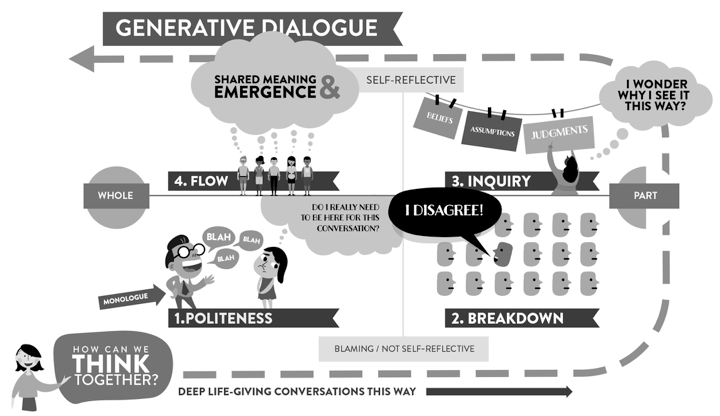Generative Dialogue
Episode #4 of the course 10 tools for change by Kate Sutherland
Glad you’re back!
Today, we’ll explore how we talk with each other. Why? Because conversations are the lifeblood of our teams and organizations. This lesson distinguishes four types of conversation and then asks how we might converse in ways that are more “generative,” aka life-giving, effective, fun, and transformative.
Four Types of Conversation
Otto Scharmer developed the Generative Dialogue framework in the late 1990s at MIT. His framework is a classic four-quadrant model. See if the illustration and description below match your own experience in groups.

1. Politeness. Group interactions typically start in the lower left quadrant, named Politeness. At the outset of a group process, people tend to conform to social conventions. We say things that we have said before, “downloading” stories, ideas, and opinions. This polite, rule-following behavior reflects a bias toward the “Whole” and non-reflective awareness, as defined by the two axes of the chart.
2. Breakdown. In Breakdown, one or more people break social convention to say what they really think or feel. This rocks the “politeness” boat, sometimes triggering others to speak about—or at least be in touch with—their authentic thoughts and feelings. A single person breaks the ice, and the group crosses the vertical axis toward the “Part.”
3. Inquiry. For a group to cross over the horizontal line up into Inquiry, at least one person begins to reflect on their thoughts and positions. People “suspend” their judgments and assumptions and loosen their grip on previously unquestioned beliefs (e.g., maybe profit is not the primary goal). This opens space for new ways of seeing and being.
4. Flow. Finally, Flow is the rarest field of conversation—a kind of peak experience where boundaries blur and people “think together.” The conversation slows down. People listen deeply and silences are pregnant with shared meaning. It is common for people to complete each other’s sentences. There is a palpable sense of oneness, as though whoever speaks voices the collective intelligence of the group.
Navigating the Quadrants
Do you recognize these four types of conversation?
If you are like me, you have tasted Inquiry and Flow and you want more!
Now that we have a map, how do we navigate there?
Here is what the Generative Dialogue framework has to say about transitions between different fields of conversation.
Given time, most groups naturally shift from Politeness to Breakdown. If groups stay in Politeness, there is likely not much safety (Lesson 1). Uncomfortable as it can be, Breakdown is a good sign.
After breaking through to Breakdown, groups often retreat back to Politeness. The conversation is too “hot,” and there is an exodus back to the comforts of social convention. It is also not unusual for groups to oscillate back and forth between the first two quadrants.
The shift from Breakdown to Inquiry begins when at least one person starts to question their own assumptions and ways of thinking or perceiving. Scharmer recommends observing “with an open mind by suspending your voice of judgment.” Rather than trying to get rid of judgment (arguably an impossible task), a powerful way forward is to inquire into our judgments and assumptions: “Is that true? What is another way to see this situation?” “What if the opposite were true?” One person authentically questioning in this way has the potential to shift the whole group into the conversation field of Inquiry.
Inquiry is a radically different field of conversation from Politeness and Breakdown. The two lower quadrants are non-reflective: People are thinking in rule-following and habitual ways. When we access the capacity to witness our thoughts—when there is a bit of distance between what we are thinking and our sense of self as a thinker—then we are freed up to think in different ways. Shifting to the upper two quadrants supports breakthroughs and innovation.
Having enough time is a necessary but not sufficient condition for reaching Flow. Dialogue ripens when groups set aside two or three hours to delve deeply into a question or challenge.
A team or group gets better at Inquiry and Flow with practice and time, developing the capacity to get to the upper quadrants quickly.
What Can I Do?
Here are three suggestions:
• Buddy up with a colleague to help each other inquire into your beliefs, assumptions, and judgments. (“Is this true?”) While this tends to be uncomfortable, it grows great muscles for generative conversations.
• Share this framework with your team. Naming the possibilities sets wheels in motion! Most people want to get to Inquiry and Flow.
• Advocate for long enough stretches of face-to-face time for your group to shift into Inquiry/Flow when breakthroughs and new thinking are important.
Tomorrow, we’ll explore Theory U, another Scharmer framework, based on his research into what else supports breakthroughs.
Till soon!
Kate
Recommended reading
Share with friends

